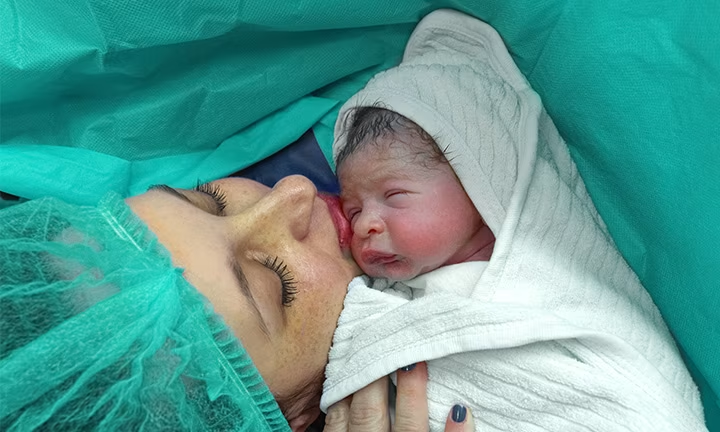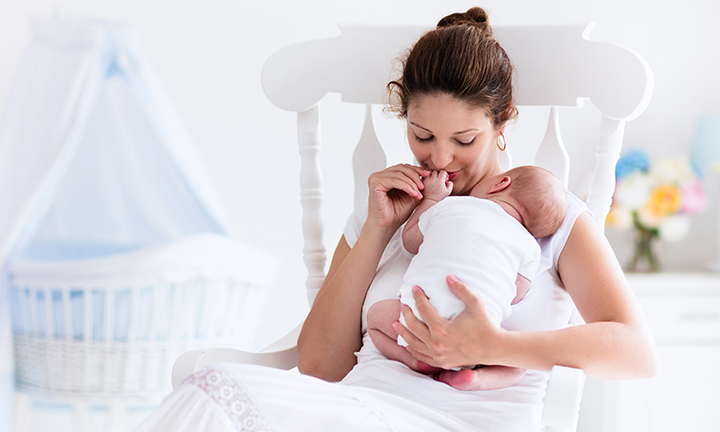
All About C-Section Scars
If you’re preparing to have a caesarean section (also known as a C-section) or you’ve recently had one, you may be wondering what your scar may look like and how it’ll heal. Well, we’ve provided all the answers to your questions! Keep reading to learn more about caesarean section incisions, healing and how to help your recovery. We’ll also provide some information on what to look out for regarding infections, when to contact your GP or midwife, and if your C-section can affect future deliveries.
What is a Caesarean Section?
A caesarean section, also known as a C-section is an operation in which you give birth to your baby through an incision made across your tummy and uterus. This may be done instead of delivering your baby in the traditional way, via vaginal birth.
Your caesarean section may be planned by your midwife or doctor if they determine that vaginal delivery is risky for you. For example, it may be scheduled if your baby is in a breech position (feet first), you have a particular health concern, or you’re carrying multiple babies (although twins are often born through vaginal birth). Occasionally, an emergency caesarean section may be needed, which is an unplanned C-section. You might need an emergency C-section if any complications arise during labour and delivery, such as a stalled labour or your baby’s head is too large for your pelvis. Your midwife or doctor will answer any questions you have about caesarean sections and discuss the benefits and risks if you’re having a planned C-section.
C-Section: Incision Types
The look of your caesarean section scar will depend on the type of C-section cut you receive in your abdomen. The C-section incision will be made in your tummy and uterus and your baby will be delivered through the opening. The two types of C-section incisions are:
What Do C-Section Scars Look Like?
Once your C-section incision heals, it will form a horizontal (or vertical) scar of about 10 to 20 centimetres long. The majority of C-sections use a horizontal cut, just above the pubic hairline, the scar may stay hidden underneath your underwear, swimsuit or pubic hair.
Vertical C-section cuts are less common, but if you receive one, you’ll have a scar running vertically just below your belly button. The C-section incision site might have redness around it and be visible at first, but it usually fades with time. If you have darker skin, it may eventually fade into a brown or white mark.
C-Section Scar Healing Stages
How long does it take for a C-section scar to heal? It takes time for your body to recover from a caesarean section, and that includes the healing of your incision site and scar. Like all scars, yours will look less prominent over time. Give yourself grace, be patient, and know that time heals all wounds – in this case, literally!
After Giving Birth
Soon after delivering your baby, your doctor will close your incisions, usually using dissolvable stitches for your C-section uterine opening. To close the abdominal incision opening, dissolvable stitches are possible, but non-dissolvable stitches or staples may also be used – and will be removed after five to seven days. As you recover from your caesarean section, you’ll stay in the hospital for up to about four days, likely being able to eat, drink, and walk around within 24 hours of your surgery. Keep in mind that you’ll probably feel some pain, especially around your C-section incision and scar. The first several days after your caesarean section are crucial in terms of general recovery and scar healing. The hospital staff will help and encourage you to get out of bed for some gentle movement as soon as possible. This can help to improve blood circulation and promote healing. You’ll also want to rest and sleep effectively, so use pain medication as instructed by your GP or midwife.
Recovering at Home
For the next few weeks, the incision site and your scar will likely feel uncomfortable and look a bit red, but there are a few things you can do at home to care for the incision and work toward having a healed C-section scar. Follow these guidelines to help promote your C-section scar recovery and general well-being:
Resuming Activities
Your abdomen will likely start to feel better after the first few weeks, but your C-section scar will continue to heal. At about four to six weeks post-surgery, your caesarean section may still feel uncomfortable. At this point, you’ll probably feel very ready for your recovery to be done! Although you may still experience some symptoms, the good news is that around six weeks after your operation you can talk to your midwife or GP about resuming activities. You may be ready to have sex again or enjoy light exercises, such as swimming and brisker walking.
Checking in With Your Midwife or GP
After your caesarean section, you’ll receive visits at home for the first few weeks from your community midwife and health visitor. This is to check how you and your baby are doing. If you had non-dissolvable stitches in your C-section wound, your community midwife will visit you after five to seven days to remove them. After the first few weeks, you can visit your health visitor at a local clinic for check-ups or if you’re having any issues. You’ll also need to make a postnatal appointment with your GP about six to eight weeks after your C-section. During this appointment, they can examine your C-section scar to determine your recovery.
C-Section Scar Infection
An important part of C-section incision care is watching for signs of infection, as any surgical wound or scar can become infected. So, what does an infected C-section incision look like? Here are some signs to look out for:
If your C-section scar or incision site becomes infected, contact your midwife or GP immediately. They will recommend the appropriate treatment.
Other Caesarean Section Complications
A caesarean section is generally a safe procedure, but you may wonder about other risks or complications developing besides infection. You’ll be happy to know that complications are generally rare and may also depend on your general health. Still, some women still ask themselves, ‘How do I know if my C-section opened inside my abdomen?’ If you’re troubled by this possibility, know that it is very rare for your uterine incision to open up. Be sure to reach out to your midwife or GP for reassurance and answers to any questions or concerns. When possible, they will discuss any caesarean section risks with you beforehand.
C-Section Scar Treatments
Your caesarean section scar is a true badge of honour! Your body worked hard to nurture your little one inside that baby bump, and you have the literal scars to prove it. These will fade and become less noticeable over time. That said, some women wonder if it's possible to make a C-section scar look less visible with treatments. If you’re curious about treatments for your C-section scar, talk to your GP or midwife first about your options for minimizing scars. Your GP might be able to help directly or may refer you to a specialist, such as a dermatologist. These are some of the preventive strategies and treatments for scars (bear in mind that not all are widely available on the NHS, so you may need to pay privately for some such as laser therapy or steroid injections):
Always consult your GP if you’re interested in any of these treatments during your C-section scar recovery process.
Vaginal Birth After Caesarean Section (VBAC)
After having a caesarean section, you may wonder how it will impact future childbirth. Many people who’ve had a C-section in the past can safely have a vaginal birth for their next pregnancy. This is known as vaginal birth after caesarean (VBAC). Occasionally, you made need some extra monitoring during labour. If you’re planning another pregnancy and wish to have a vaginal birth, discuss your options with your midwife or GP. They will assess what’s the safest option for you and your baby. In some cases, another caesarean may be recommended.
FAQS AT A GLANCE
Everyone is different and your C-section scar will take time to heal and fade. Like any other scar, it probably won’t go away completely. However, follow our recovery tips and talk to your GP and midwife about strategies to minimise the appearance of your scar.
About 6 to 8 weeks after your C-section, you will have your postpartum check-up with your GP to assess your recovery.
The Bottom Line
We hope this guide has helped answer your questions and concerns about Caesarean section cuts and scars! All in all, your midwife and doctor aim to provide you and your baby with the safest and best possible delivery and recovery. By following a healthy and gentle routine for your C-section scar recuperation, you're likely to recover effectively, avoid infections, and get back to some normal activities within about six weeks. Although you may encounter some pain, itching, and discomfort on your C-section scar, be aware that those symptoms may only be transitory. You've accomplished a small marvel and bear the marks as evidence! However, if you wish to minimise your C-section mark, consult your GP regarding common scar treatments. Learn more about those various postpartum issues you may encounter, such as postpartum bleeding or postpartum hair loss.
How We Wrote This Article The information in this article is based on the expert advice found in trusted medical and government sources, such as the National Health Service (NHS). You can find a full list of sources used for this article below. The content on this page should not replace professional medical advice. Always consult medical professionals for full diagnosis and treatment.
- NHS. ‘Caesarean Section’.
- NHS. ‘Caesarean Section (C-section)’.
- NHS. ‘Caesarean Section: What Happens’.
- NHS. ‘Caesarean Section: Recovery’.
- NHS. ‘Caring For Your Wound After Having a Caesarean Section’.
- NHS. ‘Recovering After Your Caesarean Birth’.
- NHS. ‘Treatment: Scars’.
- Tommys. ‘Recovering at Home After C-section’.
- Tommys. ‘What Happens After C-section’.
Read more about Newborn Baby
Related Articles
Join Pampers Club and get:








